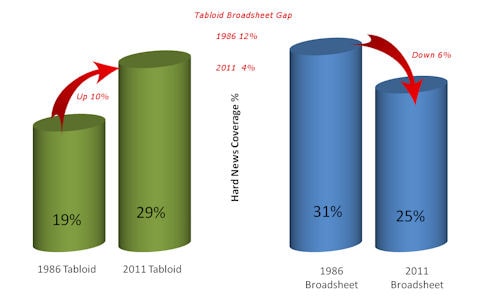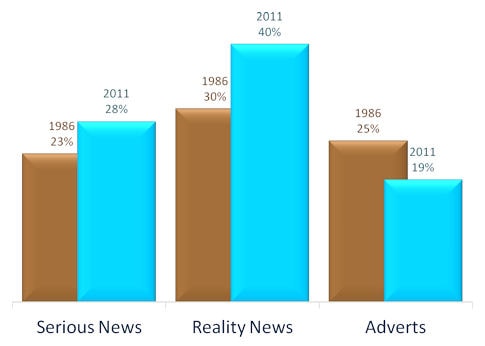In this ever-changing world of online PR strategies and social media campaigns, the humble national newspaper is still of great importance to PROs. Particularly as so many clients still put positive national print coverage above all other campaign objectives.
Which is why it’s vital for every PR professional to know what makes news in the nationals. But how is the digital age affecting the nationals’ news agenda? And how has it changed over recent years? Clarion Communications compared national newspapers from 2011 with their 1986 equivalents.
A clear finding is that newspapers are impinging on each other’s traditional territories – with all papers across the spectrum now broadly reporting identical content. For a while tabloids are now more likely to give space to “hard” news, including politics and business, broadsheets are increasingly covering celebrity and other populist news. And while newspapers attempt to keep up with digital rivals, their news coverage has become homogenised – as tabloids and broadsheets move closer than ever before in terms of style, content and subject matter.
The Tabloid Broadsheet News Gap - 1986 to 2011 compared

But while newspapers have changed in many ways since 1986, they are exactly the same in others – with the nationals’ news agenda for Summer 1986 and Summer 2011 full of almost identical subjects, including Royal Wedding Mania (Andy and Fergie versus William and Kate), Troubled Pop Stars (Boy George versus Amy Winehouse) and Soccer Bad Boys (Maradonna’s controversial Hand of God World Cup goal versus Ryan Giggs personal revelations). Howard Bowden, head of news at Clarion Communications, says: “There have been seismic changes in daily and Sunday newspapers over the past 25 years, from the arrival of colour photography to the advent of online news. But news stories themselves remain constant – from crime and the economy to politics and celebrity – and we thought it would be interesting to analyse how the news agenda has changed, particularly as papers have traditionally set the news agenda for the rest of the media.”
How the content of newspapers has changed - 1986 compared to 2011

“The most fascinating discovery is just how much the once-clear distinction between tabloids and broadsheets has disappeared – you’ll still only find Page Three in The Sun, of course, but once you get past that it’s often very hard to spot the difference between the ‘quality’ and ‘popular’ press.”
Howard adds: “Clearly by looking at a single month, our findings are coloured by specific stories of the moment, but it’s clear that distinctions across the newspaper landscape are being eroded.
“People are increasingly used to consuming news from websites and social media, where information is much more standardised in terms of format and style – and papers are having to ditch traditional styles, resulting in a merging of papers into a single, homogenised style of news reportage.
“Ultimately there’s no getting away from the fact that newspapers’ ability to set the news agenda is on the decrease – and it’s difficult to see how the traditional distinctions between tabloids and broadsheets can ever be revived.”
Methodology
Clarion Communications compared national newspapers from 2011 with their 1986 equivalents. Working alongside Redshift Research, Clarion took issues of tabloids, midmarkets and broadsheets – dailies and Sundays – from the same days 25 years apart, and analysed what made up news in the first six pages. The research involved comparing editions of The Sun, Daily Mail, Daily Telegraph, News of the World, Sunday Express and Sunday Times on identical days in July 1986 and July 2011, specifically in terms of column inches over the first six pages, based on news story categories. As the News of the World ceased publication in mid-July 2011, the Sunday Mirror and People were substituted in its place.
PR Masterclass: The Agency Growth Forum
Our experts will each give you a 20-minute Masterclass on what we've identified as the 11 most important elements in running a modern, profitable and successful PR firm.
Taking place on Wednesday 26th November in London, both virtual and in person tickets are available.
Tickets on sale now!
PR MasterclassIf you enjoyed this article, sign up for free to our twice weekly editorial alert.
We have six email alerts in total - covering ESG, internal comms, PR jobs and events. Enter your email address below to find out more:








